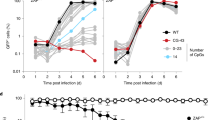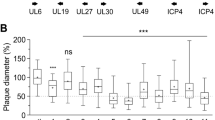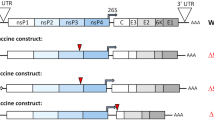Abstract
Influenza A virus leads to yearly epidemics and sporadic pandemics. Present prophylactic strategies focus on egg-grown, live, attenuated influenza vaccines (LAIVs), in which attenuation is generated by conferring temperature sensitivity onto the virus. Here we describe an alternative approach to attenuating influenza A virus based on microRNA-mediated gene silencing. By incorporating nonavian microRNA response elements (MREs) into the open-reading frame of the viral nucleoprotein, we generate reassortant LAIVs for H1N1 and H5N1 that are attenuated in mice but not in eggs. MRE-based LAIVs show a greater than two-log reduction in mortality compared with control viruses lacking MREs and elicit a diverse antibody response. This approach might be combined with existing LAIVs to increase attenuation and improve vaccine safety.
This is a preview of subscription content, access via your institution
Access options
Subscribe to this journal
Receive 12 print issues and online access
$209.00 per year
only $17.42 per issue
Buy this article
- Purchase on Springer Link
- Instant access to full article PDF
Prices may be subject to local taxes which are calculated during checkout




Similar content being viewed by others
References
Stohr, K. The global agenda on influenza surveillance and control. Vaccine 21, 1744–1748 (2003).
Neumann, G., Fujii, K., Kino, Y. & Kawaoka, Y. An improved reverse genetics system for influenza A virus generation and its implications for vaccine production. Proc. Natl. Acad. Sci. USA 102, 16825–16829 (2005).
Ulmer, J.B., Valley, U. & Rappuoli, R. Vaccine manufacturing: challenges and solutions. Nat. Biotechnol. 24, 1377–1383 (2006).
Brown, B.D., Venneri, M.A., Zingale, A., Sergi Sergi, L. & Naldini, L. Endogenous microRNA regulation suppresses transgene expression in hematopoietic lineages and enables stable gene transfer. Nat. Med. 12, 585–591 (2006).
Barnes, D., Kunitomi, M., Vignuzzi, M., Saksela, K. & Andino, R. Harnessing endogenous miRNAs to control virus tissue tropism as a strategy for developing attenuated virus vaccines. Cell Host Microbe 4, 239–248 (2008).
Kelly, E.J., Hadac, E.M., Greiner, S. & Russell, S.J. Engineering microRNA responsiveness to decrease virus pathogenicity. Nat. Med. 14, 1278–1283 (2008).
Edge, R.E. et al. A let-7 MicroRNA-sensitive vesicular stomatitis virus demonstrates tumor-specific replication. Mol. Ther. 16, 1437–1443 (2008).
Bartel, D.P. MicroRNAs: target recognition and regulatory functions. Cell 136, 215–233 (2009).
Selbach, M. et al. Widespread changes in protein synthesis induced by microRNAs. Nature 455, 58–63 (2008).
Baek, D. et al. The impact of microRNAs on protein output. Nature 455, 64–71 (2008).
Bartel, D.P. MicroRNAs: genomics, biogenesis, mechanism, and function. Cell 116, 281–297 (2004).
Artzi, S., Kiezun, A. & Shomron, N. miRNAminer: a tool for homologous microRNA gene search. BMC Bioinformatics 9, 39 (2008).
Makeyev, E.V., Zhang, J., Carrasco, M.A. & Maniatis, T. The MicroRNA miR-124 promotes neuronal differentiation by triggering brain-specific alternative pre-mRNA splicing. Mol. Cell 27, 435–448 (2007).
Hale, B.G., Randall, R.E., Ortin, J. & Jackson, D. The multifunctional NS1 protein of influenza A viruses. J. Gen. Virol. 89, 2359–2376 (2008).
Kok, K.H. & Jin, D.Y. Influenza A virus NS1 protein does not suppress RNA interference in mammalian cells. J. Gen. Virol. 87, 2639–2644 (2006).
Palese, P. & Shaw, M. Orthomyxoviridae: the viruses and their replication. in Fields Virology vol. 2, edn. 5 (eds. Knipe, D.M et al.) 1648–1689, (Lippincott Williams and Wilkins, Philadelphia, 2006).
Burnside, J. et al. Deep sequencing of chicken microRNAs. BMC Genomics 9, 185 (2008).
Williams, A.E., Perry, M.M., Moschos, S.A. & Lindsay, M.A. microRNA expression in the aging mouse lung. BMC Genomics 8, 172 (2007).
Landgraf, P. et al. A mammalian microRNA expression atlas based on small RNA library sequencing. Cell 129, 1401–1414 (2007).
Barad, O. et al. MicroRNA expression detected by oligonucleotide microarrays: system establishment and expression profiling in human tissues. Genome Res. 14, 2486–2494 (2004).
Schickli, J.H. et al. Plasmid-only rescue of influenza A virus vaccine candidates. Philos Trans. R. Soc. Lond. B Biol. Sci. 356, 1965–1973 (2001).
Hoffmann, H.H., Palese, P. & Shaw, M.L. Modulation of influenza virus replication by alteration of sodium ion transport and protein kinase C activity. Antiviral Res. 80, 124–134 (2008).
Reed, L. & Muench, H. A simple method of estimating fifty percent end points. Am. J. Hyg. 27, 493–497 (1938).
Li, S. et al. Priming with recombinant influenza virus followed by administration of recombinant vaccinia virus induces CD8+ T-cell-mediated protective immunity against malaria. Proc. Natl. Acad. Sci. USA 90, 5214–5218 (1993).
Shapiro, G.I. & Krug, R.M. Influenza virus RNA replication in vitro: synthesis of viral template RNAs and virion RNAs in the absence of an added primer. J. Virol. 62, 2285–2290 (1988).
Quinlivan, M. et al. Attenuation of equine influenza viruses through truncations of the NS1 protein. J. Virol. 79, 8431–8439 (2005).
Fodor, E. et al. Rescue of influenza A virus from recombinant DNA. J. Virol. 73, 9679–9682 (1999).
Park, M.S., Steel, J., Garcia-Sastre, A., Swayne, D. & Palese, P. Engineered viral vaccine constructs with dual specificity: avian influenza and Newcastle disease. Proc. Natl. Acad. Sci. USA 103, 8203–8208 (2006).
tenOever, B.R. et al. Multiple functions of the IKK-related kinase IKKepsilon in interferon-mediated antiviral immunity. Science 315, 1274–1278 (2007).
Pall, G.S. & Hamilton, A.J. Improved northern blot method for enhanced detection of small RNA. Nat. Protocols 3, 1077–1084 (2008).
Acknowledgements
This material is based upon work supported in part by the US Army Research Laboratory and the US Army Research Office under grant number 54677-LS-YIP. J.T.P. is supported by the NYU-MSSM Mechanisms of Virus-Host Interactions National Institutes of Health T32 training grant (no. AI007647-09). B.R.t. is supported in part by the Pew Charitable Funds. We thank A. Garcia-Sastre for giving us polyclonal A/PR/8/34 (MSSM, NY); G. Sen for ISG54 (Cleveland Clinic, OH, USA); A. Fernandez-Sesma (MSSM, NY) for primary human dendritic cell RNA; A. Tarakhovsky (Rockefeller University, NY) and D. O'Carroll (EMBL, Monterotondo, Italy) for Dicer−/− murine fibroblasts; E. Makeyev (Nanyang Technological University, Singapore) for firefly luciferase constructs containing miR-124 MREs and control SV40 3′ UTRs; and P. Palese (MSSM, NY) for pPol-I driven nucleoprotein vector, monoclonal nucleoprotein and A/PR/8/34 NS1. We thank members of the Palese and Garcia-Sastre labs for advice, reagents and comments during the course of this work.
Author information
Authors and Affiliations
Contributions
J.T.P. and B.R.t. designed and wrote the manuscript. Animal studies were conducted by A.M.P. and M.A.C. Experiments were done by J.T.P., A.M.P. and M.H.L. Cloning and rescue of H5N1 reassortants was done by J.S.
Corresponding author
Supplementary information
Supplementary Text and Figures
Supplementary Figures 1–7 (PDF 1201 kb)
Rights and permissions
About this article
Cite this article
Perez, J., Pham, A., Lorini, M. et al. MicroRNA-mediated species-specific attenuation of influenza A virus. Nat Biotechnol 27, 572–576 (2009). https://doi.org/10.1038/nbt.1542
Received:
Accepted:
Published:
Issue Date:
DOI: https://doi.org/10.1038/nbt.1542
This article is cited by
-
MicroRNA let-7 and viral infections: focus on mechanisms of action
Cellular & Molecular Biology Letters (2022)
-
Going live: How microRNAs might bring living vaccines back into the fold
Nature Medicine (2018)
-
Proof-of-concept study: profile of circulating microRNAs in Bovine serum harvested during acute and persistent FMDV infection
Virology Journal (2017)
-
MicroRNA-134 regulates poliovirus replication by IRES targeting
Scientific Reports (2017)
-
Optimal Down Regulation of mRNA Translation
Scientific Reports (2017)



